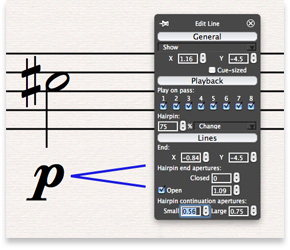Avid released Sibelius 7 yesterday. Highlights in the new version:
A new UI. The most apparent change is a new user interface with dockable, tabbed panels. The design borrows heavily from Microsoft’s Office Ribbon, though a more subdued appearance makes it look just as comfortable on the Mac. My guess is that power users may just hide the whole thing and stick to keyboard shortcuts, but it should do wonders for discoverability for new users or more casual users not comfortable with that.
There’s also a nice new inspector, which looks a lot more usable and less-clumsy than the previous version.

The best UI feature: real full-screen mode, including on the Mac. The mixer has also been redesigned.
Better sharing for text, graphics, and more: Direct PDF and EPS export is now built in, with new “publisher-quality typography and graphics import/export.” It’s the feature least likely to be immediately noticed, but it could well be the best reason to upgrade. There’s also the ability to “sync or import” notation with Pro Tools, and of course you can publish to the iPad notation tool we’ve covered previously. (Links below.)
MusicXML interchange. Speaking of sharing, full, built-in MusicXML interchange support makes it possible to share notation with other tools, including Finale. (Side note: I hope this puts some pressure on the free tool Lilypond to support MusicXML export; it’s really frustrating that that’s missing. The proprietary tools are now more compatible than the free tool.)
64-bit support. Sibelius is indeed the first major native 64-bit notation software (at least, other than open source options which can be compiled for 64-bit). I’m not sure what the real-world implications of performance would be in notation itself – Sibelius was always plenty fast – but I’ll try to find out. It’s still a no-brainer. As for anyone using samples, this should provide 64-bit sample hosting, which is a very important feature for larger sample libraries / memory usage.
More sounds. Sibelius has long included licensed samples, but now following the Avid acquisition, the Avid virtual instruments folks have added their own symphony, rock, pop, organ, and (via Sample Logic) even band and drum and bugle sounds. We’ll have to hear how they sound and how well-integrated they are with the notation tools.
What about notation? The one thing I sense may be missing from this version is improvements to notation capabilities themselves. Because of the breadth of scoring possibilities, there’s almost always room for enhancement, and this update, while it appears a worthy investment for many users, seems from the information I have now not to address the core scoring functionality. That said, hidden in the feature set is better support for fonts which could have the greatest impact on how your scores actually appear: improved OpenType support adds compatibility with “the latest OpenType fonts, including advanced features like ligatures, and employ them in text frames with full DTP-level capabilities.” The ability to do that is very important to engraving and layout.
I hope to learn more about what the implications are for Sibelius scoring in Pro Tools, and how this version has changed.
By the way, Sibelius has also improved their academic pricing. US$295 is the student/teacher price, but what’s best about this is that they’re including four years of free upgrades for students. I don’t know that I’ve ever seen that (usually precisely the opposite, excluding academic customers from upgrades), and it’s a nice touch.
Previously, our coverage of Avid’s notation tool for iPad:
Not Quite Sibelius for iPad, but Avid Scorch Could Become an iTunes of Notation
Tablet Scores: Avid Answers Our Scorch Questions; Bluetooth Page Turners for iPad, Android
